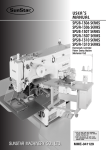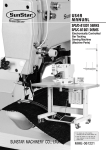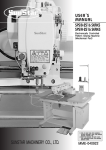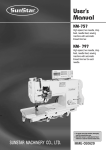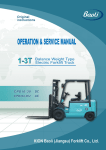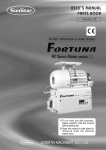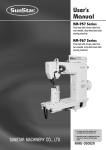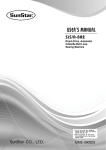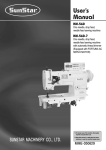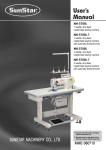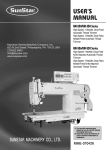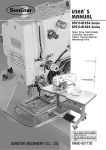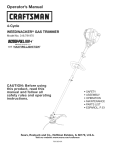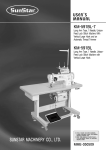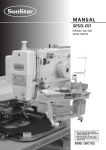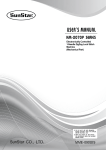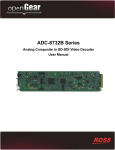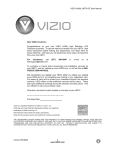Download SUNSTAR MACHINERY CO., LTD.
Transcript
R USER ’ S MANUAL SPS/D-B1202 SERIES SPS/C-B1202 SERIES Electronically Controlled Button Sewing Machine (Mechanical Part) SUNSTAR MACHINERY CO., LTD. 1) FOR AT MOST USE WITH EASINESS, PLEASE CERTAINLY READ THIS MANUAL BEFORE STARTING USE. 2) KEEP THIS MANUAL IN SAFE PLACE FOR REFERENCE WHEN THE MACHINE BREAKS DOWN. MME-051130 lity a u tQ Besst Pricevice Be st Ser Be 1. Thank you for purchasing our product. Based on the rich expertise and experience accumulated in industrial sewing machine production, SUNSTAR will manufacture industrial sewing machines, which deliver more diverse functions, high performance, powerful operation, enhanced durability, and more sophisticated design to meet a number of user’s needs. 2. Please read this user’s manual thoroughly before using the machine. Make sure to properly use the machine to enjoy its full performance. 3. The specifications of the machine are subject to change, aimed to enhance product performance, without prior notice. 4. This product is designed, manufactured, and sold as an industrial sewing machine. It should not be used for other than industrial purpose. R SUNSTAR MACHINERY CO., LTD. SPS / D- B 1 2 0 2 - 0 1 ① Sunstar Pattern System ② Series C: Motor belt-type D: Motor direct drive-type ④ Button Type 01 : Small-Size Button (Mechanical Type Wiper) 02: Large-Size Button (Mechanical Type Wiper) 03 : Small & Large Size Button (Solenoid wiper Type Wiper) ③ Button S/M Model Name Contents 1. Machine safety regulations 6 2. Machine Specifications 9 3. Machine Structure 1) Names of each part of the machine 4. Machine Installation 1) 2) 3) 4) 5) Machine installation conditions Electric installation conditions How to install the table The assembly of peripheral parts Change of parameters according to setting of thread wiper specifications 5. Preparations before operating the machine 1) How to supply oil 2) How to grease 3) How to attach needle 4) Checking needle and thread 5) How to pass upper thread 6) Threading the lower thread 7) How to take the bobbin case on and off 8) How to adjust the tension of the upper thread and the lower thread 9) How to wind the lower thread 10) How to operate a pedal 11) Disposing the waste oil 6. How to repair the machine 1) 2) 3) 4) 5) 6) 7) Adjusting the height of the needle bar Adjusting the needle and the shuttle How to adjust the eccentricity of thread take-up crank axis Adjusting the lower shaft gear and the rocking shaft gear Adjusting the position of shuttle upper spring How to adjust the ascending range of button clamp How to adjust the button clamp holder tension 10 10 11 11 11 11 14 15 16 16 16 17 17 17 17 18 18 19 19 19 20 20 20 21 21 22 22 23 8) Adjusting the parts of thread release 9) Adjusting the parts of wiper 10) Adjusting the parts for trimming 11) Adjusting the devices for main thread adjustment 12) Adjusting the winder devices 13) Setting up the synchro position(C Series) 14) Mounting the Direct Motor and Adjusting Method(D Series) 15) Setting up the X-Y origin 16) How to adjust the feeding plate 17) Checking the setting position of button clamp 18) How to set up the button clamp adjusting plate 19) How to attach the spacer spring plate 23 24 27 29 29 30 31 31 32 32 33 33 7. Cause of Breakdown and Troubleshooting 34 8. Pattern List 36 9. Drawing of Table 37 1) SPS/D-B1202 2) SPS/C-B1202 37 38 10. Gauge List 39 11. Option List 39 1 MACHINE SAFETY REGULATIONS Safety instruction on this manual are defined as Danger, Warning and Notice. If you do not keep the instructoins, physical injury on the human body and machine damage might be occurred. Danger : This indication should be observed definitely. If not, danger could be happen during the installation, conveyance and maintenance of machines. Warning : When you keep this indication, injury from the machine can be prevented. Notice : When you keep this indication, error on the machine can be prevented. 1-1) Machine Transportation Danger 1-2) Machine Installation Notice Only trained and experienced people should treat the machine who are fully understand the safety rules. For conveyance, follow the below directions. ⓐ More than two people to a minimum should convey the machine. ⓑ For a protection of safety accident, wipe away the oil stained on machine. Owing to the improper environment for machine installation, physical damages on the human body and machine can be occurred. Please follow below conditions. ⓐ When you unwrap the packing of the machine, try from above in order. Especially careful of nails put into edges of wood box packing. ⓑ Since dust and humidity can cause pollution and abrasion, you should install airconditioner with regular cleaning. ⓒ Put in a place of no direct ray of light. If the machine is exposed in direct ray of light for a long time, transformation of color and shape can be happened. ⓓ To get enough space in case of repair, make the machine 50cm apart from the right and left and back side of wall to a minimum. ⓔ EXPLOSION HAZARDS Do not operate in explosive atmospheres. To avoid explosion, do not operate this machine in an explosive atomosphere including a place where large quantities of aerosot spray product are being used or where oxygen is being administered unless it has been specifically certified for such operation. ⓕ The machines where not provided with a local lighting due to the feature of machine. Therefore the illumination of the working area must be fuifilled by end user. [Refer] Details for installation of machine is described in‘4. Machine Installation.’ 1-3) Machine Repair Danger 6 If you have any problems on the machine, troubleshooting should be handled by the designated A/S engineers. ⓐ Before cleaning and repairing machine, cut off the main power and wait for 4 minutes until the machine comes to be completely discharged. ⓑ You should not change the specification of machine and any part of machine without consulting with our company. Those changes can threaten the safety of machine during the operation. ⓒ You should exchange from the used one into SWF guaranteed devices. ⓓ After finishing troubleshooting, cover the all covers that are uncovered during repairing. 1-4) Machine Operation Warning SPS/D(C)-1202 Series are made for industrial use to perform button sewing to fabrics or its similar materials. Please observe the following principles. ⓐ Read the manual to understand on the operation of machine perfectly. ⓑ Wear suitable clothes and cap for safe operation. ⓒ During operation, don’t make you body close to operating part of machine such as needle, hook, take-up lever or pulley. ⓓ Do not remove a safety plate and covers during operation ⓔ Be sure the grounding lines in connected. ⓕ Before opening electricity box such as control box, cut off the supply of electricity and confirm if the switch is“off”. ⓖ When inserting thread into a needle or before inspecting after sewing, be sure the machine is stopped. ⓗ Do not turn on the power during pedaling. ⓘ Do not use several motor per a electric outlet. ⓙ Install the machine apart from noise occurrence area such as high frequency welding machines as far as possible. ⓚ Be careful- When the upper feed plate comes down to press. Otherwise, the finger or hand hight be hurt at smacking. Warning 1-5) Devices for safety Notice Belt will crush or amputate finger or hand, keep cover in place before operating, turn off power before inspecting or adjusting. ⓐ Safety label : It describes cautions during operating the machine. ⓑ Thread take-up cover : It prevents from any contact between body and take-up lever. ⓒ Motor Cover(D Series) : It prevents from insertion of hands, feet or clothes by Motor. Belt Cover(C Series) : It prevents from insertion of hands, feet or clothes by V-belt Motor. ⓓ Label for specification of power : It describes cautions for safety to protect against electric shock during rotating the motors. ⓔ Finger guard : It prevent from contacts between a finger and needle. ⓕ Safety plate : It protects eyes against needle breaks. ⓑ ⓒ ⓐ ⓕ ⓔ ⓓ 7 1-6) Caution Mark Position Caution mark is attached on the machine for safety. When you operate the machine, observe the directions on the mark. Position of Warning Mark CAUTION 경 고 Do not operate without finger guard and safety devices. Before threading, changing bobbin and needle, cleaning etc. switch off main switch. 손가락 보호대와 안전장치 없이 작동하지 마십시오. 실, 보빈, 바늘교환시나 청소전에는 반드시 주 전원의 스위치를 꺼 주십시오. CAUTION 경 고 Hazardous voltage will cause injury. Be sure to wait at least 360 seconds before opening this cover after turn off main switch and unplug a power cord. 고압 전류에 의해 감전될 수 있으므로 커버를 열 때는 전원을 내리고 전원 플러그를 뽑고 나 서 360초간 기다린 후 여십시오. 1-7) Contents of Marks Caution 1) CAUTION 경 고 Do not operate without finger guard and safety devices. Before threading, changing bobbin and needle, cleaning etc. switch off main switch. Warning 손가락 보호대와 안전장치 없이 작동하지 마 십시오. 실, 보빈, 바늘교환시나 청소전에는 반드시 주전원의 스위치를 꺼 주십시오. 2) CAUTION 경 고 Hazardous voltage will cause injury. Be sure to wait at least 360 seconds before opening this cover after turn off main switch and unplug a power cord. 고압 전류에 의해 감전될 수 있으므로 커버 를 열 때는 전원을 내리고 전원 플러그를 뽑 고 나서 360초간 기다린 후 여십시오. 8 2 Name of Model SPS/D(C)-B1202-01 SPS/D(C)-B1202-02 SPS/D(C)-B1202-03 Speed Max. 2,500spm (Standard : 2,200spm) Button Size ф8~ф20mm Wiper Specification Needle ф8~ф32mm Mechanical Type Wiper ф8~ф32mm Solenoid Type Wiper DP×17 #14 Hook Semi-Rotary Standard Shuttle Hook Button Clamp Lift Max. 13mm No. of Patterns Max. 99 Patterns (Standard: 33 Patterns) No. of Stitches Max. 10,000 Stitches Enlargement / Reduction Memory P-ROM Proper Temperatare of machine running Proper Humidity of machine running Main Motor 20%~200% 5℃~40℃ (41℉~104℉) 20%~80% D Series Direct Drive AC Servo Motor C Series AC Servo Motor Power Consumption Power 1ф : 100~240V / 3ф : 200V~440V, 50/60Hz 600VA 9 3 MACHINE STRUCTURE 1) Names of each part of the machine Arm Mortor Cover Thread Stand Safety Plate Operation Box Power Switch Control Box Pedal Switch 10 4 MACHINE INSTALLATION 1) Machine installation conditions A. Do not use the machine where the voltage is over regular voltage ±10% to prevent accidents. B. For safe operation of the machine, use the machine under the following conditions. Surrounding Temperature During Operation : 5℃~40℃ Surrounding Temperature During Maintenance : -10℃~60℃ C. Humidity : Between 20~80%(Relative humidity) 2) Electric installation conditions A. Power Voltage ·The power voltage must be between regular voltage ±10%. ·The frequency of the power should be regular frequency (50/60HZ)±1%. B. Electromagnetic Wave Noise Use separate power with strong magnetics or high frequency products, and do not leave the machine near them. C. Use low voltage when supplements or accessories are being adhered. D. Be careful not to have water or coffee be spilled into the Controller and Motor. E. Do not drop the Controller or Motor. 3) How to install the table A. Fix the oil tub holder ①, oil holder ②, control box ③, and main switch ④ on the table. B. In case of SPS/C-B1202 series, attach the bed cushion rubber to the table. ② ① ③ ④ Cushion Rubber [ Fig. 2 ] [ Fig. 1 ] C. In case of SPS/D-B1202 series, attach the bed cushion rubber ① and safety switch supporting rubber ② to the table. ② ① [ Fig. 3 ] 11 D. Add the hinge metal and hinge rubber to the bed. Then insert the fixing bolt into the hinge metal hole of point ① and fix the table as shown in the picture. Bolt Hinge Rubber The machine should be carried by more 2 people for safety Danger ① Hinge [ Fig. 4 ] E. In case of SPS/D-B1202 series, assemble the safety switch bracket ① on the bed as in the figure. Move the safety switch bracket up and down to make sure that the safety switch supporting rubber② is tightly pressed by the safety switch③, and then fasten the screw④. ① ② ④ ③ [ Fig. 5 ] F. Stand the machine as shown in the picture, and then fix the machine on the table after inserting the fixing bolts into the hinge metal holes of point ①. Danger Since the machine is not perfectly installed on the table, extreme care is needed when you make the machine stand up not to have any accident occurred. ① Bolt ① [ Fig. 6 ] G. Put the “V”-Belt in between the pulley and the motor while the machine is standing as in the picture.(C Series) Pulley V-Belt Motor Cover [ Fig. 7 ] 12 H. After connecting the “V”-Belt, if the fixing nuts① and ② are vertically unfastened sufficiently tension occurs in belt D due to the weight of motor C. At this point, first screw in fixing nut ① A, then nut ② in fixing screw B tightly. And, finish the cable connection between the embroidery machine and the control box, then fix the cable wiring under the table as shown in the Figure. (The length of cable should be set up considering when the machine is put aside.) (C Series) D ① ② C [ Fig. 8 ] I. Be sure to connect the earthing conductor (green)between the sewing machine and the motor. And also, connect the earthing conduct or between the control box and the motor. (C Series) Conductor [ Fig. 9 ] J. In case of D series, connect the conduct of sewing machine and control box as in the picture. Conductor [ Fig. 10 ] 13 4) The assembly of peripheral parts A. Attach the motor cover to the back side of machine and sides by using fixing bolts (In case of C series, attach the belt cover by using fixing screws for the rear (3EA) and the side (2EA).) Fixing Screw Fixing Screw Motor Cover Velt Cover Fixing Screw C series D series [ Fig. 11 ] [ Fig. 12 ] For safety, motor cover and safety plate should be attached to the machine. Caution B. Install the thread stand on the table. C. Fix the button case base① in the bottom of flat table to the easy working position using a screw②. And insert the button case③ into the button case base①, then fix it with a fixed screw④. ③ ② [ Fig. 13 ] 14 ④ ① [ Fig. 14 ] 5) Change of parameters according to setting of thread wiper specifications ·Parameters are changed according to mechanical thread wiper specifications upon initialization. ·For change of parameters according to setting of thread wiper specifications, refer to the following table : Function No. A14 A31 Mechanical Type 0 1 Electronic Type 1 0 Wiper Specification ·For more information, refer to“Memory Switch Function Table”. 15 5 PREPARATIONS BEFORE OPERATING THE MACHINE 1) How to supply oil A. Check the remaining oil in the oil tank in the arm and bed, and supply the oil sufficiently on the arrowed parts on the Figure 16 with a lubricator. Caution Be sure to supply oil when operating the machine for the first time and when the machine has not been used for a long time. [ Fig. 16 ] B. Open the hook cover and supply oil till the shuttle race ring is surrounded by oil. Put the hook cover closed after finishing. Caution For safety, keep the hook cover closed during operating. Shuttle Race Ring Hook Cover [ Fig. 17 ] 2) How to grease Supply a little grease on the arrowed parts in the Figure16. Too much grease prevents the clamp from moving up and down, therefore an error message -[“Er 05”] is displayed. [ Fig. 18 ] 16 3) How to attach needle Loosen the needle fixing screw① in the needle bar, place the long groove of needle② toward to user and push it until the needle upper point gets to the needle insert hole, then fix it with the needle fixing screw①. ① ② [ Fig. 19 ] 4) Checking needle and thread Refer to the right table when selecting the needle and thread to use according to working conditions. (Cotton thread or span thread is available.) Needle Upper Thread Lower Thread DP×17 #14 #60 #80 #50 #60 #40 #60 #60 #60 5) How to pass upper thread Place the thread take-up lever on the top position, and hang the upper thread as shown in the Figure20. About 40mm of the upper thread should come out from the needle eye. [ Fig. 20 ] 6) Threading the lower thread A. Insert bobbin ① into bobbin case ② as shown in the Figure21. Caution Insert the bobbin to turn clockwise when seen from behind the bobbin case 25mm ③ ② ① B. After setting the lower thread through the crack of the bobbin case, insert the thread through thread hole ③. C. Adjust the lower thread to hang 25mm out of thread hole ③. [ Fig. 21 ] 17 7) How to take the bobbin case on and off Opening the hook cover, hold the knob ① of bobbin case and push into the shuttle until sounding. Caution If you start operating the machine when a bobbin case is not perfectly installed, thread can be tangled of the bobbin case would be protruded. ① Bobbin Case [ Fig. 22 ] 8) How to adjust the tension of the upper thread and the lower thread A. Adjusting the Tension of the Upper Thread When the tension adjusting nuts ③ and ④, of thread tension adjusting unit ① and subtension adjusting unit ②, are turned clockwise the upper thread is tightened. And loosens when turned the other way around. ④ ② ① ③ [ Fig. 23 ] B. Adjusting the Tension of the Lower Thread The lower thread becomes tight when tension adjusting screw ① is turned clockwise, as shown in the picture. When the screw is turned the other way the lower thread is loosened. ① [ Fig. 24 ] 18 9) How to wind the lower thread A. Press SELECT on operation box and select . B. Insert the bobbin into the thread winder drive shaft ② on thread winder base ①, attched to the upper cap. C. Adhere the bobbin winder lever ③ closely to a bobbin, then let the machine run by pressing pedal. D. After the bobbin winder lever takes off from a bobbin, cut the thread of bobbin by using bobbin winder knife ④. [ Fig. 25 ] 10) How to operate a pedal A. Install a pedal switch in the proper position for the convenience of work. B. If you step on pedal one step, the button clamp descends, and if take off your feet from the pedal, it ascends. C. If you step on two step the pedal switch after stepping on it one step, the sewing starts, and after finishing it,the button clamp ascends. ↓ → [ Fig. 26 ] 11) Disposing the waste oil When the oil receiving oiler at the bottom of the table is full, take it off to empty. Caution Oiler Spread out some fabrics or papers on the floor when you attach or remove the oil receiving container. [ Fig. 27 ] 19 6 HOW TO REPAIR THE MACHINE The machine is set to be the best condition at the factory. Do not make any discrete adjustments on the machine and replace genuine parts approved by the company only. Caution 1) Adjusting the height of the needle bar ① Loosen the needle bar clamp screw① at its lowest point, adjust the upper punched mark of the needle bar to conform to the bottom of the needle bar bushing as shown in the Figure28, then tighten the needle bar clamp screw①. Upper punched mark [ Fig. 28 ] 2) Adjusting the needle and the shuttle A. As shown in the Figure29, go up the needle bar from its lowest point, and conform the lower-left punched mark of the needle bar to the lower bushing of the needle bar. Needle Bar Lower Bushing Lower punched mark [ Fig. 29 ] B. After unfastening the shuttle drive screw①, open the inner hook pressure bar ② left to right and remove the shuttle Race ring ③ from the (large) shuttle ④. C. Make the shuttle hook point accord with the center of the needle. And make the needle and the front face of the shuttle drive connect each other to prevent the needle from curving. Then, tighten the drive screw ① firmly. D. After unfastening the (large) shuttle screw⑤, turn the large hook adjustment shaft ⑥ to the left to right and adjust the (large) shuttle ④ so that the needle and the shuttle hook point is 0.05~0.1mm apart from each other. E. After adjusting the (large) shuttle ④ in place, adjust the rotary direction of the (large) shuttle ④ so the needle and the (large) shuttle ④ is 7.5mm apart from each other. Then, tighten the (large) shuttle screw ①. For safety, make sure all the screws are tightened firmly after adjusting the (large) shuttle. Caution 0mm 7.5mm → → 0.05~0.1mm ② ② → ⑤⑥ ④ ③ 20 ① 3) How to adjust the eccentricity of thread take-up crank axis A. Disassemble the face plate from an embroidery machine, then remove a clamp screw in the thread take-up crank axis. ③ B. Loosen a fixed screw of the thread take-up crank axis in the left of arm. C. Rotate the thread take-up crankshaft③ to place its eccentric part to the upper direction. And adjust the driver’s groove horizontally. ② ① D. Tighten the fixed screw of the thread takeup crank axis, then reassemble the clamp screw of the thread take-up crank axis. [ Fig. 31 ] 4) Adjusting the lower shaft gear and the rocking shaft gear A. Unfasten screws ①, ②and ③. B. While having the upper shaft turning, move the rocking shaft gear in the direction of the arrow to the position where it will move easily without load. The machine may not operate when the rocking shaft gear in not in the right position. Caution C. Have the oscillator shaft collar(right) stick to the bed surface , and then tighten the collar screw. D. Turn the oscillator shaft collar(right), still sticking to the bed surface , in the direction of the arrow and make adjustments so the end of the shuttle drive will rotate smoothly with the backlash of under 0.1mm. If there is too much backlash the machine may make more noise than usual during operation. And if there is not enough backlash, the machine may not operate. Caution E. Tighten screw ① and ③ back on firmly. ③ Oscillator Shaft Collar(R) below 0.1mm →← ① ② [ Fig. 32 ] 21 5) Adjusting the position of shuttle upper spring After removing the lower feed plate and the needle plate from the machine, unfasten the screw of the shuttle upper spring. Then, adjust the shuttle upper spring so that the backside of the needle and comes to point in the vertical direction, and the center of the needle will come to the middle of interval horizontally. After the adjustment is done, tighten the screw back on firmly. Caution The thread may be disconnected or the thread strand may be unfastened if there are scratches or if the surface is rough around the Shuttle upper spring. Always check the surface of the spring before operating the machine. ① ① ① [ Fig. 33 ] 6) How to adjust the ascending range of button clamp To adjust the ascending range of button clamp, take out its tension adjusting screw①, loosen the fixed screw②, adjust the holder bar of button clamp up and down to place it to the suitable position, then tighten the fixed screw②. And attach the tension adjusting screw① on the original position again. ③ ② ① 13mm [ Fig. 34 ] ※ The maximum rising height of button clamp is 13mm from the presser foot. (The rising height of button clamp upon delivery is adjusted to 10~11mm.) 22 [ Fig. 30 ] 7) How to adjust the button clamp holder tension Adjust it smoothly to the extent that sewing cloth does not move during sewing, and fix it with the tension adjusting nuts - ① and ②. ②① [ Fig. 35 ] 8) Adjusting the parts of thread release A. How to Set the Thread release Notch Place the notch so that the right side of the slot of the thread release notch ① touches circumference of the notch screw ②, and then fix with a screw. Caution ② ① The remaining amount of thread may not be enough or not be regular and the thread may be unfastened from the needle if the notch is not set in the right position. Thread Trimmer Cam [ Fig. 36 ] B. How to Set the Thread Release Stopper ⓐ Remove the thread release return spring. ⓑ After unfastening the thread release stopper screw, adjust the trimming drive link and the thread release lever pin 0.3mm apart from each other. Then, attach the arm to the thread delay stopper completely. When the thread release stopper is pushed to the right, the space between the trimming drive link and the thread release lever pin is reduced. And it is enlarged when the stopper is pushed to the left. ⓒ Hang on the thread release return spring. For safety, use a tool when removing or attaching the thread release return spring. Caution Thread Release Lever Pin Thread Trimming Driving Link Return Spring Screw →→ 0.3mm Widen Narrow Thread Release Stopper [ Fig. 37 ] 23 C. How to adjust the opening capacity of the thread guide disk ⓐ Unfasten the thread release adjusting plate screw. ⓑ Open the thread guide disk by operating the trimming devices. ⓒ Adjust the opening capacity to 0.6~0.8mm for normal material and 0.8~1mm for heavy material. To increase the opening capacity, widen the angle between the thread release plate and narrow the angle to reduce the opening capacity. ⓓ Tighten the screw after the adjustment. If the disk is not opened appropriately, the amount of remaining thread may be not enough or not regular, and the disk may not be closed completely. Caution Widen → → Floating Amount Narrow Upper Shaft To Thread Tension Adjusting Ass’y Screw Thread Tension Adjusting Plate To Tension Release Link [ Fig. 38 ] 9) Adjusting the parts of wiper A. Adjusting method of kinematic type wiper(SPS/D(C)-B1202-01, 02) ⓐ Unfasten the wiper base plate bolt ②. ⓑ When the thread wiper and the needle center are in a straight line, adjust the thread wiper base③ up and down that the interval between the needle① and the thread wiper can be 2.5mm, then tighten the clamp②. ⓒ Unfasten the wiper rod bolt ④. ⓓ Adjust the thread connecting rod⑤ up and down that the thread wiper under sewing standby can have the interval of 15~17mm from the needle center, then tighten the thread wiper rod clamp④. ⓔ The thread wiper spring attached on the thread wiper base has the function to hold upper thread after thread trimming, and its proper tension is about 20~30g. (A little stronger than the tension of lower thread in the bobbin case) If the wiper is not placed in the right position, the wiper may collide with the presser foot or needle during the operation, and the wiper may not move properly. Caution ② Needle ① ③ 2.5mm ④ 15~17mm [ Fig. 39 ] 24 ⑤ ⑥ [ Fig. 40 ] B. Installation and adjusting method of solenoid wiper (SPS/D(C)-B1202-03) ⓐ Fix the wiper base plate with screw as shown in the figure41. [ Fig. 41 ] ⓑ Fix the wiper base at the opposite direction with two screws as shown in the figure42. [ Fig. 42 ] ⓒ Connect the connector located at solenoid with the connector came out from arm. [ Fig. 43 ] 25 ⓓ Loosen the base clamp②, adjust the thread base③ up and down that the interval between the thread wiper and the needle center can be 2.5mm when the thread wiper and the needle center are in a straight line, then tighten the clamp② ② ③ [ Fig. 44 ] 2.5mm ① [ Fig. 45 ] ⓔ Loosen the thread crank clamp④, adjust the thread wiper crank⑤ that the thread wiper under sewing standby can have the interval of 15~17mm from the needle center, then tighten the wiper crank clamp④. ④ 15~17 ⑤ [ Fig. 46 ] [ Fig. 47 ] ⓕ Finally, after arranging the connector as shown in the figure48, attach the wiper cover ⑥ by using wiper cover joint screw⑦. [ Fig. 48 ] ⓖ The thread wiper spring⑧ attached on the thread wiper base has the function to hold upper thread after thread trimming, and its proper tension is about 20~30g. (A little stronger than the tension of lower thread in the bobbin case)If the tension of the thread wiper spring is strong, the thread may come upward the button. To use the thread wiper solenoid, the sewing related function number, A-18 should be set up to “100”. In addition to, check if A-14 is set up to“1”and A-31 to“0”. Caution 26 10) Adjusting the parts for trimming A. Setting the position of the trimming Cam Set the upper shaft collar and the trimming cam 1.7mm apart from each other and place the trimming cam where the trimming cam carving line accords with the upper shaft carving point. Then, tighten screw ①. Caution If the trimming cam is not placed in the right position, the trimming operation may not be made correctly or the machine may be lock. Thread Trimmer Cam 1.7mm Carving Line → → Upper Shaft Carving Point Upper Shaft Upper Shaft Collar ① [ Fig. 49 ] B. How to adjust the link stopper ⓐ With the needle bar in its lowest position, check if there is enough clearance between thetrimming cam roller and both ends of the trimming cam when the trimming drive link is pushed in the direction of the arrow( ) within the trimming cam moving part. Caution If there is not enough clearance between the trimming cam roller and both ends of the trimming cam, trimming may not be operated correctly or the machine may be lock when beginning to sew or trimming. ⓑ Make the end of the link stopper screw touch part of the trimming link stick when the trimming cam roller is inserted into the trimming cam moving part. Then, tighten the nut. Thread Trimmer Cam Roller →→ →→ Caution If the position is not set appropriately, the return to the previous point after trimming may be delayed and the first stitch may not be tight enough. Thread Trimming Driving Link Clearance Clearance Thread Trimmer Cam Link Stopper Screw Link Stopper Screw Thread Trimmer Connecting Rod Thread Trimmer Connecting Rod Nut [ Fig. 50 ] 27 C. Setting the trimming shaft in place ⓐ Unfasten the trimming drive link screw and the trimming shaft collar screw. ⓑ Make the trimming shaft step accord with part of the arm. ⓒ Tighten the screws. Caution If the position is not adjusted appropriately, trimming may not be operated correctly or the machine may be lock. Thread Trimmer Cam Thread Trimmer Shaft Screw Thread Trimming Collar for Driving Link Thread Trimmer Shaft Caution 0.3mm Thread Trimmer Driving Link If the link stopper is not set in the right position, trimming may not be operated correctly and the machine may be lock. Screw → → D. Setting the Link Stopper in Place ⓐ Unfasten the trimming drive link stopper screw while trimming is not operated and have the trimming drive link and the trimming drive link stopper notch 0.3mm apart from each other. ⓑ Tighten the screw. →→ [ Fig. 51 ] 0.3mm Thread Trimmer Driving Link Stopper [ Fig. 52 ] E. Setting the Thread Trimming Solenoid in Place ⓐ After unfastening the thread trimming solenoid bracket screw, have the trimming shaft and the thread trimming solenoid rotary link 0.5mm apart from each other and tighten the screw back on. ⓑ Unfasten the thread trimming solenoid rotary link screw and drive the thread trimming solenoid rotary link manually to move the trimming shaft collar 6.8mm in the direction of the arrow. Then, tighten the screw back on. ⓒ Check if the trimming shaft collar returns to its place when the thread trimming solenoid rotary link returns. Caution If the position is not set right, the trimming return or the thread delay may be delayed to bring poor sewing quality. Screw Thread Trimmer Solenoid Bracket Solenoid →→ Screw 0.5mm Thread Trimming Rotation Link Thread Trimming Rotation Link → → 6.8mm Thread Trimmer Shaft [ Fig. 53 ] 28 F. Adjusting the Moving Knife and the Fixed Knife ⓐ When the needle bar stops at the upper position, use the trimming lever adjustment screw to adjust space A between the thread separation point of the moving knife and the needle plate hole as indicated in the table.(4.5mm) ⓑ Use the fixed knife screw to adjust space B between the fixed knife and the needle plate cover as indicated in the table. (0.5mm) ⓒ after the adjustment, check the position of the mes by manual trimming operation. Caution Trimming may not be operated or there may not be enough remaining thread if the knife is not set inappropriately Fixed knife B → → Needle Plate Cover A B 4.5mm 0.5mm → → A Moving Knife [ Fig. 54 ] 11) Adjusting the devices for main thread adjustment A. When the tension control nut ① of the thread control device is turned clockwise, the upper thread is tightened and becomes loose as the nut is turned counterclockwise. Adjust the tension according to the sewing conditions such as material, thread, number of stitches etc. B. To tighten the take-up lever spring, use a driver to turn the groove ② on the edge face of the thread tension control device shaft clockwise. And to make the spring relax, turn it counerclockwise. (Standard operating quantity is 6∼8mm, and tension is about 30g∼50g.) Thread Take-up Spring ① ② [ Fig. 55 ] 12) Adjusting the winder devices A. To adjust the winding capacity of the bobbin, use the beginning position of the winding control plate, and after unfastening the screw, turn the plate in direction A for large winding capacity and turn in direction B for small winding capacity. B. Place the winding drive wheel 4mm away from the upper shaft bushing(F) and tighten the screw. Upper Shaft Bobbin Bobbin Winder Driving Wheel 4mm A Upper Shaft Bushing(F) B Bobbin Winder Adjusting Plate [ Fig. 56 ] [ Fig. 57 ] 29 13) Setting up the synchro position(C Series) A. Installing the synchronizer ⓐ Fix the synchoronizer on the back side of arm. ⓑ Adjust the gap between pulley and synchronizer to be 2.5mm, then fasten the fixing screw for pulley. Pulley 2.5mm Upper Shaft Pulley Screw Magnetic Holder Upper Shaft Bushing(R) Sychronizer [ Fig. 58 ] B. Adjusting the position of position detector ⓐ Adjust the position of take-up lever to be same as Fig. 61 by turning the pulley. At this time, the white carving sign of pulley should be straight line with the carving sign of arm. ⓑ Adjust the clamp screw① in the pulley’s punched point, and tighten the clamp screw① where the pulley’s punched pointⓐ conforms to its inscribed pointⓑ. ⓒ Unfasten the screw ② on the N.D carving sign and move to the right and left, then let it suspen on the place where the needle bar just start ascending from the bottom. About 3mm Direct ion of Rotati on [ Fig. 59 ] 30 ② [ Fig. 60 ] Direction of Rotation ① [ Fig. 61 ] 14) Mounting the Direct Motor and Adjsuting Method(D Series) A. When you mount the coupling on the servo-motor, fit the screw No.1 of coupling to the flat surface of the servo motor shaft and make the clearance between the coupling and servo motor 0.7mm. B. When you mount the coupling on the upper shaft, fit the screw No.1 of coupling to the flat surface of the upper shaft and make the clearance between the coupling and upper shaft bushing(R) 2mm. C. After mounting both couplings, check the positions of each screws to the aligned. ※ If the positions of each screws are not aligned, the needle does not stop normal position. Screw NO.1 Servo Motor O-ring Upper Shaft Flat Surface Upper Shaft Rear Bushing ARM 2 Coupling 0.7 [ Fig. 62 ] 15) Setting up the X-Y Origin A. How to set up X-axis Origin ⓐ Separate a bed cover (left). ⓑ Move the button inserted into the button clamp to the center of X-axis. ⓒ As seen in the figure, unfasten the bolts of X-sensor plate and let the end of X-sensor plate locate on the center of sensor, then fasten the bolts with screw-driver. Screw X-sensor plate Sensor [ Fig. 63 ] 31 B. How to set up Y-axis Origin ⓐ Separate a bed cover ( right ). ⓑ Move the center of work clamp foot to be placed on the center of Y-axis. ⓒ As seen in the figure, unfasten the bolts of Y-sensor plate and let the end of X-sensor plate locate on the center of sensor, then fasten the bolts with screw-driver. Sensor Screw Y-sensor plate [ Fig. 64 ] 16) How to adjust the feeding plate A. Select Pattern No.“0”at the operation box. B. Press [Ready] key to ascend the button clamp that the machine can return to the origin. C. Adjust the feeding plate① that its center can place to the center of presser bar cover②. ② ① [ Fig. 65 ] 17) Checking the setting position of button clamp A. Select Pattern No.“0”at the operation box. B. Press [Ready] key to ascend the button clamp that the machine can return to the origin. C. Insert the button into the button clamp①. D. Press the button clam of Step 1 to descend its holder. At this time, turn the pulley for the error message “ [ Er 03”] to display on the LCD. E. Remove your foot from the pedal, and turn the pulley to check if the needle point conforms to the button’s center. F. If the needle point does not insert into the button’s center, loosen the fixed screw② of the button clamp bracket, and fix it that the needle point can be inserted into the button’s center. G. After adjusting, check the pattern form that the needle is exactly inserted into the button hole. 32 ② ① needle point conform Button [ Fig. 66 ] 18) How to set up the button clamp adjusting plate A. Insert the button into its clamp while the machine stops, and check that it is exactly inserted. B. Loosen the button clamp adjusting screw①, and adjust that the space between the button clamp adjusting plate② and its adjusting screw① can be 0.5~1mm. 0.5~1.0mm ① ② ③ [ Fig. 67 ] 19) How to attach the spacer spring plate ② ③ ④ ① 3.5~4mm A. Place the spacer spring to the button’s center, adjust it to be projected to 3.5~4mm from the button’s center to the spring’s edge, and fix the spacer spring plate ③ to the button clamp bracket①. B. To adjust the height of spacer spring, loosen the screw④, place the spring to the suitable position, and fix the screw④. [ Fig. 68 ] 33 7 CAUSE OF BREAKDOWN AND TROUBLESHOOTING No. Condition of Breakdown Cause of Breakdown Troubleshooting Loosing of belt tension and damage Adjust the belt tension or exchange it on belt 1 2 3 Error on operation or drive of machine Fuse shortage for main power or circuit Check the fuse shortage of main shaft drive motor in a controller box or exchange it Deviation from Y and Y limit of feed bracket Move the feed bracket to normal place (inside limit switch) Slackness of main drive belt Adjust the belt tension Bad position of stopping position Due to improper synchro position Adjust setting position of synchro Exchange the needle Needle bent Damage on needle(Bending of needle, cracks on needle hole or groove, and abrasion or transformation of needle tip) Wrong installation of needle Install the needle properly Contact of needle with shuttle Adjust the distance properly between a needle and shuttle Wrong insertion of thread Insert the thread properly Wrong installation of needle (Height Reinstall the needle. of needle or direction of needle) 4 Thread is cut Damage on needle (Bending of needle, cracks on needle hole or groove, and abrasion or transformation of needle tip) Exchange the needle. Excessive tension of upper thread and under thread Adjust the tension 5 Stitch skipping Excessive tension and stroke of take-up lever spring Adjust the tension and stroke of takeup lever spring Crack on the controlling hole of shuttle surface spring Exchange the shuttle surface spring Use of bending needle Exchange the needle. Use of improper sized needle compared with using thread Exchange the needle. Wrong installation of needle Reinstall the needle. Improper timing for needle and shuttle Readjust the timing for needle and shuttle Improper gap between groove and shuttle point Readjust the timing for needle and shuttle Excessive tension of take-up lever spring and stroke 34 Adjust the tension of take-up lever spring and stroke No. Condition of Breakdown Cause of Breakdown Weak tension of upper thread 6 Errorin thread tightening Weak tension of lower thread Improper timing for needle and shuttle Laxity of exchanging tension between movable mes and fixed mes 7 Error in trimming Troubleshooting Readjust the tension of upper thread. Readjust the tension of lower thread. Readjust the timing for needle and shuttle Readjust the tension of fixed mes. Abrasion and crack on blade of movable mes and fixed mes Exchange the movable mes and fixed mes. Wrong position of trimming cam. Readjust the position of trimming cam 35 8 PATTERN LIST Pattern Pattern No. Range of Sewing X (mm) Y (mm) No of Threads Pattern Pattern No. No of Threads Range of Sewing X (mm) Y (mm) 1 6-6 3.4 3.4 18 6 3.4 0 2 8-8 3.4 3.4 19 8 3.4 0 3 10-10 3.4 3.4 20 10 3.4 0 4 12-12 3.4 3.4 21 12 3.4 0 6-6 3.4 3.4 22 16 3.4 0 8-8 3.4 3.4 23 6 0 3.4 10-10 3.4 3.4 24 10 0 3.4 12-12 3.4 3.4 25 12 0 3.4 9 6-6 3.4 3.4 26 6-6 3.4 3.4 10 8-8 3.4 3.4 27 10-10 3.4 3.4 11 10-10 3.4 3.4 28 6-6 3.4 3.4 12 6-6 3.4 3.4 * 29* 10-10 3.4 3.4 13 8-8 3.4 3.4 30 5-5-5 2.9 2.5 14 10-10 3.4 3.4 31 8-8-8 2.9 2.5 * 16* 17* 6-6 3.4 3.4 32 5-5-5 2.9 2.5 8-8 3.4 3.4 33 8-8-8 2.9 2.5 10-10 3.4 3.4 * 6* 7 * 8* 5 15 ※ The magnifying and reduction range (X and Y) of standard sewing shown above is 100% 66 patterns including 33 patterns can be additionally provided. ※ In case of the pattern of“*”mark of Sewing Pattern No., a thread is trimmed after finish of first sewing to remove a line through sewing patterns. In case of SPS/C-B1202-01 and 02, press the pedal once more after finish of first sewing, or continuously press and release the pedal until second sewing begins. In case of SPS/C-B1202-03, just one time pressing of the pedal will do. A. If the central distance between use buttonholes does not conform for the standard sewing range of Sewing Pattern No., magnify or reduce the sewing range to adjust it. B. After the Sewing Pattern Number and the sewing range (X, Y) are changed, don’t forget to check if the needlepoint conforms to the buttonhole with regard to [Checking Pattern Shape]. C. Rate of magnifying and reduction according to the sewing range Sewing Area 2.4 X,Y(mm) Expansion & Reduction (%) 71 36 2.6 2.8 3.0 3.2 3.4 3.6 4.0 4.3 4.5 4.7 5.2 5.6 6.0 6.2 6.4 76 82 88 94 100 106 118 126 132 138 153 165 176 182 188 37 1) SPS/D-B1202 DRAWING OF TABLE 9 38 2) SPS/C-B1202 10 GAUGE LIST MODEL SPS/D(C)-B1202 Button Size Small Button Midium Button Large Button External diameter of Button (mm) ф8~ф15 ф10~ф20 ф15~ф32 (Y) 0~3.5 0~4.5 0~6.5 (X) 0~3.5 0~4.5 0~6.5 Thickness 1.3 (2.2) 2 (2.7) 2.7 (3.2) Stitch Size (mm) Punched mark Button Clamp Code Ass’ y No. Right Left Punched mark Punched mark 23-033A-120B A 23-056A-120B B 23-063A-120B C (23-050A-120B) 1 (23-063A-120B) 2 (23-076A-120B) 3 23-026A-120B A 23-053A-120B B 23-066A-120B C (23-047A-120B) 1 (23-060A-120B) 2 (23-073A-120B) 3 Needle Plate Cover 10-042A-120B 10-043A-120B 10-044A-120B Feed Plate 23-043A-120B 23-058A-120B 23-071A-120B ※ ( ): Special Option 11 NAME Code No. Button Spacer Ass’ y 23-182A-120B Feed Guide Bracket 20-149A-120B Feed Plate Small Button 23-094A-120B Midium Button 23-095A-120B Large Button 23-096A-120B 39







































